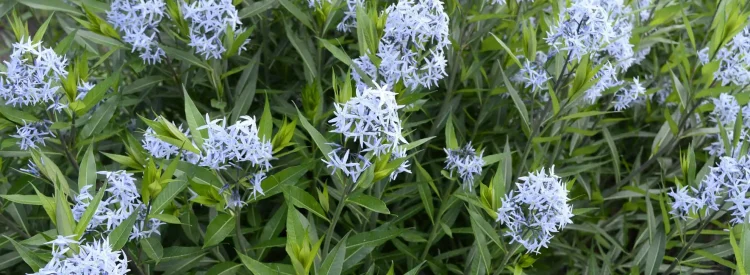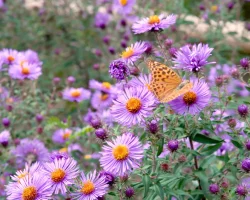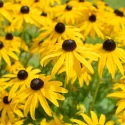These native flowers put on a show 3x a year. In the spring, star-shaped blue flowers appear at the top of elegant stalks. (These plants can also go by the common name bluestar.) Enjoy a wall of tightly packed leaves in the summer. In the fall, their leaves turn vibrant shades of yellow. There are 10+ species of amsonia, most native to different parts of North America. Let’s make amsonias a new trend for North American gardens—they’re easy to grow and easy to love. Scroll on for planting tips and to meet some nursery-friendly species.
Why is amsonia a secret?
The real question we have to ask today is: why do non-native tulips get the late-spring spotlight instead of native amsonias? Both bloom around the same time, but only one puts on a stunning display in the fall. (Tulips look amazing for two weeks, then drop their petals everywhere before withering up into stringy brown leaves, which remind me of hair caught in a shower drain.)
It is a mystery why this stunning native plant is not more widely known. It’s time for every American and Canadian in the eastern and southern regions to plant some and fix this in our lifetimes.
Is amsonia a good choice for my yard?
Yes, if…
- You want a low-maintenance perennial that requires minimal care once established.
- You have a spot with full sun to part sun and soil that drains reasonably well.
- You love three-season interest: spring flowers, summer greenery, and glowing fall color.
- You’re okay with a plant that grows 2–4 feet tall (or don’t mind cutting it back after blooming).
- You like planting in groups and want a big visual payoff from a few well-chosen plants.

Why amsonia matters
There are so many benefits to planting native amsonias. Some benefits include:
- Easy-care: once native amsonias are established (which usually takes the first year), they usually thrive on rainfall alone.
- They can be tall—unless you’d like them shorter: Most species get 3-4′ tall. If this is too tall for you, you can cut them to half their height after blooming.
- Lots of species for north-to-south options: Amsonia has multiple species that thrive throughout North America—scroll on to meet your favorites
- Flowers in the spring, foliage in the fall: As mentioned earlier, this plant offers multi-season interest and lots of visual drama
When we say multi-season drama, we mean it:

Spring
Enjoy their blue-tinted star flowers every spring. Amsonias bloom at the same time as peonies (which are non-native, but garden icons.)

Summer
After amsonias flowers fade, the leaves remain as a verdant wall. Thinner bladed amsonia leaves provide excellent textural contrast against summer blooming favorites like bee balm, coneflower, and mountain mint.

Fall
Amsonias turn shades of butterscotch in the fall. It's like someone plugged your garden into a neon light socket. Pair with purple or blue native asters for a Monet-inspired fall.
Types of native amsonia
There are 10+ species of native amsonia that offer resilient beauty for United States gardens. Here are some species you may encounter:
Eastern Bluestar, Willow Amsonia, or Willowleaf Amsonia
Amsonia tabernaemontana
(It has a few names—we’ll call it Eastern bluestar here.) The range of Eastern bluestar is huge: from Massachusetts to Texas! It thrives in full sun to part sun gardens and flowers in the spring. It gets a little tall—2-4’—if this bothers you, trim back the plant to half its height after it blooms. Thankfully, most local plant nurseries stock this plant.

Fringed Bluestar, or Texas Amsonia
Amsonia ciliata
Native to the southern United States (from Florida to Texas), this amsonia offers more rounded blue star-flowers and needle-like leaves—a striking combo. It also comes with a bonus: the ability to thrive in hot southern summers. It’s a little shorter (18-24″) and needs well-drained soil to thrive.
Looking for the other species?
As mentioned earlier, there are over 10 species of amsonia native to North America. No matter where you live in the continental United States, there is a species for you. Click or tap to find an overview of several species, including the two we just met:
10+ Native Species of Amsonia
North American native species of amsonia include:
| Common Name | Latin Name | Native Region |
|---|---|---|
| Southeastern United States | ||
| Fringed Bluestar | Amsonia ciliata | Southeastern U.S. |
| Louisiana Bluestar | Amsonia ludoviciana | Louisiana, Mississippi, Georgia |
| Rigid Bluestar | Amsonia rigida | Georgia to Louisiana |
| Shining Bluestar | Amsonia illustris | Mississippi Valley, Southeastern U.S. |
| Hubricht’s Bluestar | Amsonia hubrichtii | Arkansas, Oklahoma |
| Midwest, Mid-Atlantic and Northeastern United States | ||
| Eastern Bluestar | Amsonia tabernaemontana | Central and Eastern U.S. |
| Southwestern United States | ||
| Jones’ Bluestar | Amsonia jonesii | Arizona, New Mexico, Utah, Colorado |
| Kearney’s Bluestar | Amsonia kearneyana | Arizona |
| Palmer’s Bluestar | Amsonia palmeri | Arizona, New Mexico, Texas |
| Tharp’s Bluestar | Amsonia tharpii | New Mexico, Texas |
| Woolly Bluestar | Amsonia tomentosa | Southwestern U.S. |
| Gulf Coast Region | ||
| Creeping Bluestar | Amsonia repens | Eastern Texas, Southwestern Louisiana |

No matter which one you plant, there is one to avoid.
Let’s not plant European bluestar
Planting flowers, shrubs, and trees native to North America is what The Plant Native is all about. Which is why we should steer clear of one amsonia that’s native to Europe: European bluestar (Amsonia orientalis). Take a moment to check the nursery tag to make sure you’re not planting this bluestar species if you’re gardening in North America. You’ll miss out on all the benefits of planting native.
Where native amsonia shines in your yard
These plants can be a focal point in a foundation planting, alongside a driveway, or at the back of a pollinator garden.







Amsonia has a cousin you might know: milkweed
Amsonia is in the same plant family as another native garden star: milkweed.
What do milkweed and amsonia have in common?
Their shared plant family, Apocynaceae, is known for its milky white sap, which contains latex and bitter compounds. That sap can be toxic or irritating if eaten, which helps protect plants in this family from being munched by animals. This is one reason both amsonia and milkweed are deer-resistant.
If you have a latex allergy or sensitive skin, wear gloves and avoid getting the sap on your skin when planting or cutting amsonia.
Amsonias live for 10-20 years
Planting amsonia is one of the most beautiful and lazy types of gardening. (There is nothing wrong with wanting beauty for less work!) Plant these native beauties, and they can last for 10-20 years, slowly growing outwards from their starting clump.
Plant 5+ native amsonias together for maximum impact
Amsonias look best when planted in groups. If you have the space, plant five or more near each other to help their spring flowers, summer greenery, and fall foliage shine.
When you’re planting a grouping of amsonia, we have a tip:
Try to get all the bluestar you need at once
Perhaps you’re detail-oriented—like we are… no shame!—and you’ve noticed that some of the Eastern bluestar pictures here and elsewhere online feature slightly different leaf shapes and flowers in varying shades of blue. We were skeptical too—is this the same plant?

Leaf shapes and flower colors for Eastern bluestar can vary widely
Eastern bluestar (Amsonia tabernaemontana) has lots of different varieties that are rarely mentioned on plant nursery tags. Plants with needle-like leaves and others with fuller leaves may both be called Eastern bluestar. Same for flowers that are a light blue or a more bluer-blue—they all might go by the same name.
This variation is normal for amsonia. The Flora of North America database notes:
“[Eastern bluestar] Amsonia tabernaemontana encompasses a great deal of morphological diversity, particularly in leaf size and shape and sepal indument and length, which is to some extent geographically correlated; therefore, the recognition of varieties seems desirable. However, the varieties are not well differentiated and tend to blend into one another, especially where their ranges overlap.”
If you want all your amsonia to “match,” buy all you need at once. You may find a different variety another season or at a different nursery. Or, embrace the varieties and collect all you can find, and enjoy spotting the tiny differences.
Where can I find native amsonia?
Looking for places to buy amsonia? Here are four sourcing ideas:
Where can I find seeds and plants?
Finding native plants can be challenging (we partly blame Marie Antoinette.) To make it easier, we’ve assembled four sourcing ideas.
300+ native nurseries make finding one a breeze
Explore 100+ native-friendly eCommerce sites
Every state and province has a native plant society; find yours
Online Communities
Local Facebook groups are a great plant source
What are good pairings for amsonias?
A great rule of thumb when planting a garden is to pick native plants that bloom from spring to fall, so that pollinators always have a treat. Since amsonias are spring bloomers, pick some other great natives that bloom in the summer and fall to plant alongside. Some ideas include:

Pairs well with
If picking native plants feels overwhelming, try three-color landscaping. Pick three colors (one of which will be blue, since you’re planting amsonias) and stick to that palette. Here’s our guide to Three-Color Native Gardens to make it easy.
And that sums up our love letter to planting native amsonias. These beautiful and striking native flowers have been strangely overlooked in landscaping—let’s change that! Amsonias deliver star-filled flowers in the spring, greenery in the summer, and jaw-dropping foliage in the fall. Plant them in groups of 5+ for the most dramatic display. Since they are perennials, plant once and they will come back year-after-year. Don’t forget to pair with natives that bloom in the summer and fall, so your garden will always be filled with flowers and pollinators. Keep the pollinator party going and visit amsonia’s cousin, in our Beginner’s Guide to Native Milkweeds, or pair with a native tree from our Best Native Trees for Front Yards. Happy planting!
Sources
- Armitage, Allan. Herbaceous Perennial Plants: A Treatise on Their Identification, Culture, and Garden Attributes. United States: Quarto Publishing Group USA, (1989), 34-35.
- Taylor, Patricia A. Easy Care Native Plants. (1996), 232-233.
- Flora of North America, Amsonia tabernaemontana
- USDA Plants Database, Amsonia ciliata
- USDA Plants Database, Amsonia tabernaemontana
- Ladybird Johnson Wildflower Center, Amsonia ciliata
- Ladybird Johnson Wildflower Center, Amsonia tabernaemontana
- Gardening Know-How, Common Amsonia Varieties – Types Of Amsonia For The Garden. December 30, 2022.
What if your feed was actually good for your mental health?
Give your algorithm a breath of fresh air and follow us.























